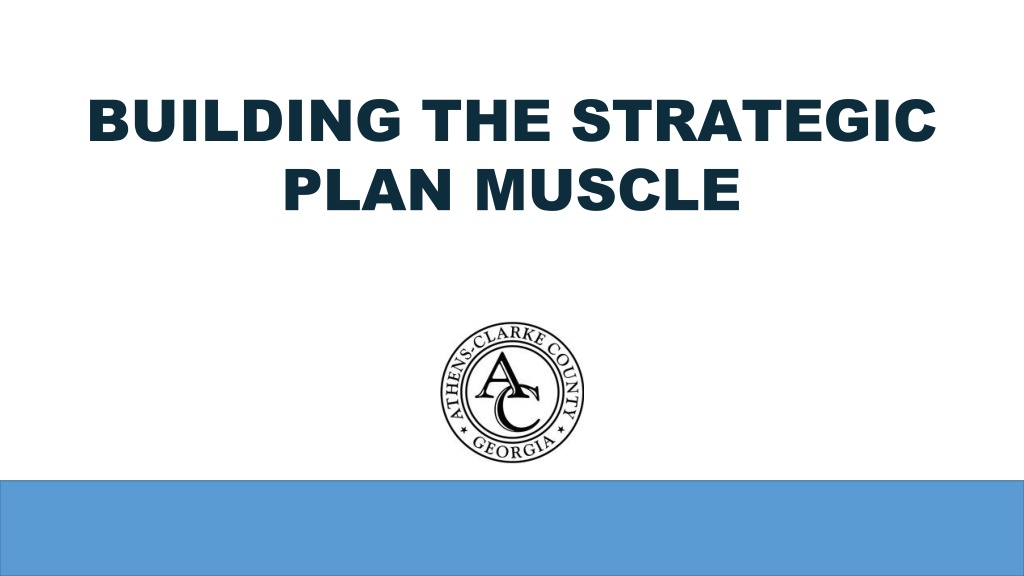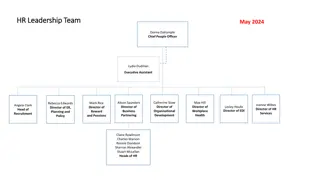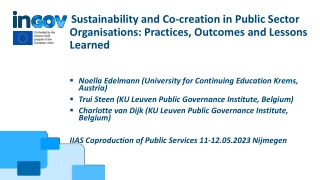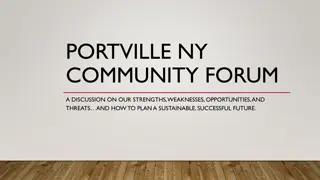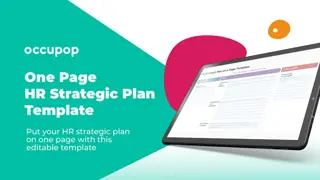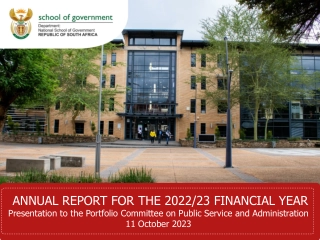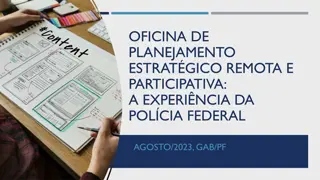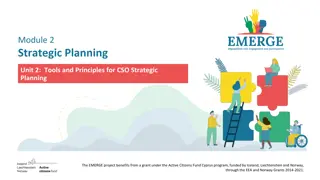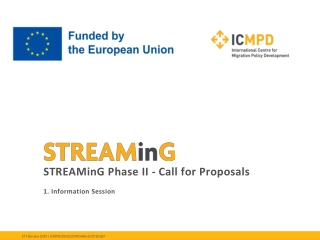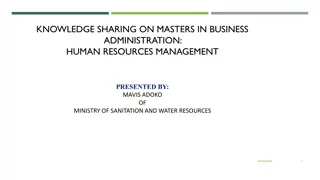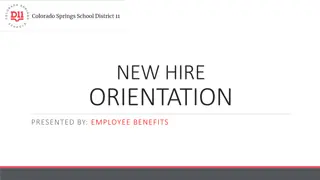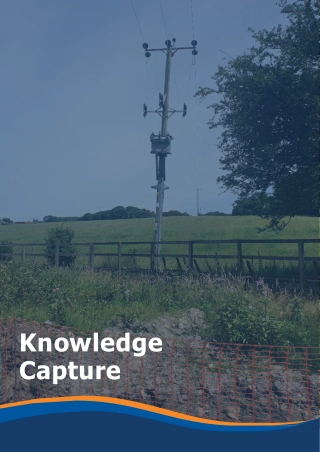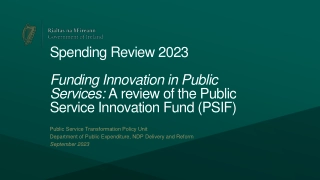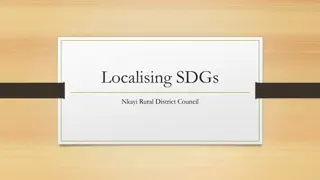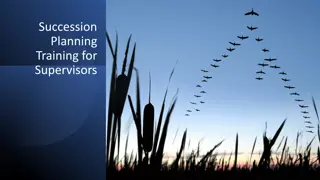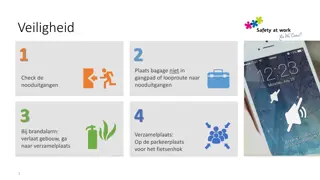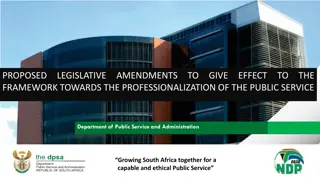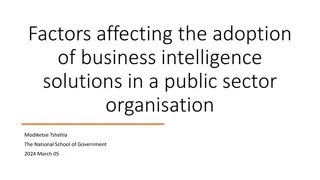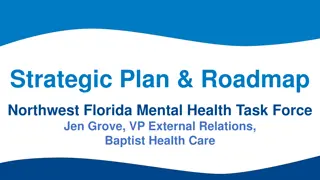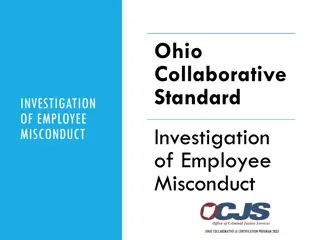Empowering Employee-Driven Strategic Planning for Public Service Organizations
Empower employees through strategic planning to address challenges in public service organizations. Focus on fostering collaboration, knowledge transfer, and employee engagement to achieve desired future states. Utilize strategies and initiatives to enhance role clarity and achieve community goals effectively.
Download Presentation
Please find below an Image/Link to download the presentation.
The content on the website is provided AS IS for your information and personal use only. It may not be sold, licensed, or shared on other websites without obtaining consent from the author. Download presentation by click this link. If you encounter any issues during the download, it is possible that the publisher has removed the file from their server.
Presentation Transcript
BUILDING THE STRATEGIC PLAN MUSCLE
Key Questions Why are 52% of local and state employees thinking of leaving public service? (MissionSquare Research Institute) How are you transferring the knowledge of long term employees to the many new ones? (12% of all GA municipal employees are eligible to retire GMA) How do you empower employees when they are constantly questioned by outside Experts?
Why Plan? Realistic picture of current state of organizations processes Share How we are getting there to foster collaboration Take systemic action, with budget support Achieve desired future state of organization
Employee Driven Local Governments face an uphill challenge in achieving Community Goals since: Elected officials & communities constantly question expertise National narrative & economy make recruiting/retaining employees challenging Empowering employees to be problem solvers and lead at all levels Employee Driven Strategic Planning is a culture game changer for organizations: Employees got in public service for a reason Experts are InHouse Trust and engage employees with fun and most important work When employees help with strategy they are more bought into implementation
Where ACCGov Has Been Annual Mayor & Commission Strategic Commitments (FY2018) Developed / Implementing Organizational Strategic Plan (Aug-Feb FY22) Connecting that through Departmental Strategic Plans (ongoing) Focus on Four Community Challenges (Summer 2020)
Role Clarity MANAGER'S OFFICE STAFF AND MAYOR & COMMISSION GOAL AREAS MAYOR & COMMISSION STRATEGIES DEPARTMENT/OFFICE LEADS INITIATIVES STAFF SUBJECT MATTER EXPERTS MILESTONES
Key Language Strategies: Statements that indicate items of critical importance to the organization, department, division, or office. In other words, they are work items designed to address strengths, weaknesses, opportunities and threats outlined in the SWOT analysis. Initiatives: Action statements that allocate resources to address how strategies will be carried out. Initiatives tend to include a scope, budget, and timeline. Milestones (and sub-milestones): Concrete steps that fill out the timeline (think: work breakdown)
Clear Process SWOTs, PESTLE Exercises All plans cross-talk Priority groups gap analysis Formation of six goal areas Strategy formation Initiative construction Initiative refinement FY23 budget process Strategic Plan adoption Goal Leads named Select Refine & present milestones Connect measures to data Goal Team formation Construction of milestones performance measures for FY23 Begin reporting Iterate
Current Focus: Implementation 98 INITIATIVES 3 YEARS (WHAT'S A YEAR 1 PRIORITY? 2? 3? ALL 3 YEARS?) EVERYTHING IN PROCESS/CONTINUO US IS ALREADY OFF THE BOARD EVERY INITIATIVE HAS AN OWNER WHO IS A SME
Introduction: The City s strategic planning efforts allow community members and City leaders to determine what is important for future success by identifying opportunities to implement new initiatives. The opportunities are supported by a vision, mission, organizational values, and goals that focus Council and staff s collective efforts thoughtfully and transparently. This document is the result of an extensive process that engaged the community, City leaders, and staff to develop this policy and decision making framework for the future.
Strategic Plan: a 10-year plan to chart the direction of the County Destination: Where we re heading Master Plans: Parks, Sewer, Fire; department-specific; long-range Maps: Guidance we need to get there C.I.P.: multi-year planning instrument to fund capital purchases Operating Budget: annual planning instrument to fund operations Money: How it s funded Annual Work Plan: a tool used to chart the steps needed in order to fulfill longer-range plans (above) and provide focus for day-to- day operations Steps: The actions we take to get to our destination 12
Strategic Plan: a 10-year plan to chart the direction of the County Question: Does this achieve the objectives of our Strategic Plan? Master Plans: Parks, Sewer, Fire; department specific; long-range Question: Is it in line with our Master Plan (if applicable)? C.I.P.: multi-year planning instrument to fund capital purchases Operating Budget: annual planning instrument to fund operations Question: How will it be funded? Annual Work Plan: a tool used to chart the steps needed in order to fulfill longer-range plans (above) and provide focus for day-to- day operations Question: What do I need to do to fulfill our long-range plan? 13
Practice, Were Talking About Practice! Products & Services Strategic Plan
Create a Draft Plan within 3 Meetings! Meeting 1 Meeting 2 Meeting 3 Products and Services Customer s Reflectio n Purpose Goals Strategies Initiatives Measures 2.5 - 3 hours 2.5 - 3 hours 2.5 - 3 hours Presentation Adria Finch and I presented at ELGL 2022
Step 1: Identify your Products and Services 1. Brainstorm all of your department s products - things that you create 2. Brainstorm all of your department s services - things that you deliver Administrative Department (Budget) Operational Department (Animal Services) Product: Line item budget allocations Product: Update SOPs & Ordinances Service: Oversee bidding process Service: Reunite lost pets with owners
Step 2: Identify all of your Customers 1. Brainstorm all of your internal customers. Who do you serve within your organization? 2. Brainstorm all of your external customers. Who do you serve within the community? Administrative Department (Finance/Budget) Operational Department (Animal Services) Internal: Police Department, Corrections, Attorney s Office Internal: Department Heads, Administrative Assistants, Project Supervisors, Contract Managers, Departmental Financial Analysts, Legislature/Council External: Animals, Residents, Non-Profit Stakeholders (i.e. Humane Society) External: Companies that bid on projects, residents that pay fees/licenses
Step 3: Conduct a Reflection SWOT Analysis Internal Strengths - resources of capabilities that can be used for accomplishing your purpose and objectives Internal Weaknesses: Deficiencies in resources or capabilities that hinder your ability to succeed External Opportunities - Factors or situations that exist beyond your department, but could positively impact it External Threats/Challenges - Factors or situations that exist beyond your department, but could negatively impact it.
Step 3: Conduct a Reflection Think about the current state: 1. Reflect on what your community needs 2. Reflect on what your community wants 3. Reflect on what your organization needs 4. Reflect on what your organization wants Using the wants and needs, conduct a Start, Stop, Continue: 5. Identify things you should start doing 6. Identify things you should stop doing 7. Identify things you should continue doing
Step 4: Identify your purpose 1. Identify what your department does 2. Identify why your department does the whats 3. Identify how the department does the whats 4. Use these to draft statements that describe the fundamental reason for the department s existence. Administrative Department (Budget) Operational Department (Animal Services) Develop and oversee the annual operating budget and CIP. Serve as internal consultants supporting departments in achieving their goals while being focused on financial sustainability of the organization through process improvements. Provide quality care and seek positive outcomes for all animals that come through our doors Protect community members and neglected animals by enforcing laws and educating the public.
Step 5: Clarify High Level Goals 1. If they exist, review broad organizational objectives, vision, mision, and values a. Cascade your goals down from these. 2. Review the customers identified in Step 2. 3. Review the reflection information identified in Step 3. 4. Identify themes from the research that you ve completed. 5. Create broad statements of things you would like to accomplish on behalf of the customers. Administrative Department (Budget) Operational Department (Animal Services) Ensure that the city delivers the services and programs that residents need through effective budgeting practices. Protect the safety of both animals and residents by reducing the number of needy and homeless animals in the community and improving legal compliance
Step 6: Establish Strategic Priorities 1. Review the reflection that you completed in step 3. 2. Write down things that must happen in order to reach the goal established in step 5: a. Things you must do well b. Barriers that you must overcome 3. Develop 2 - 4 strategic priorities Administrative Department (Budget) Operational Department (Animal Services) Identify the effective programs and operations that are most needed by residents. Improve Community Access to Animal Resources through public/private partnerships. Reduce budget variance to ensure better alignment with spending and operational needs. Maximize efforts to reunite lost pets with owners in keep them in homes where they are cared for. Tip: Make sure these aren t too narrow. If the statement sounds like something you can go and do now, it is likely an initiative, not a strategic objective.
Step 7: Developing Initiatives Plot your strategic priorities on the right hand side of a timeline. Brainstorm projects, programs, changes, etc. that need to occur in order for your to achieve strategic priority within three years. For each strategy created develop 3 - 5 initiatives. Plot these initiatives on the timeline, illustrating what needs to occur in order to achieve the strategic priority. 1. 2. 3. 4. Administrative Department (Budget) Operational Department (Animal Services) Improve Community Access: - Increase # of low cost spay/neuter clinics - Trap Neuter Release Ordinance - More Customer Friendly hours Effective City Operations: - Hire Budget performance team - Framework to measure the effectiveness - Launch budgeting engagement effort Reunite Lost Pets: - Identify technology for ACO s to use in field - Develop bilingual resources - Update Return to Owner SOP Budget Variance - Spending history to drives monthly allotments - Develop regular budget:actuals review system - Launch new budgeting software
Step 8: Establish Measurement Criteria 1. Review the strategic priorities and the timeline that you created. 2. Brainstorm the following for each strategic priority a. Outputs - deliverables or things that are done or created b. Outcomes - results that are achieved c. Metrics - things that we can measure 3. Baseline where the department is with the metric you selected. 4. Identify a reasonable target and turn it into a SMART goal (specific, measurable, attainable, relevant, timely). Administrative Department (Budget) Operational Department (Animal Services) Effective City Operations: - Reduce the total funding to less effective programs/operations from $1M to $500K. Improve Community Access: -Increase Volunteer and Foster hours -Pet Food Pantry Utilization Budget Variance: - Reduce budget variance from 15% to 3% within three years. Reunite Lost Pets: -Length of Stay at Shelter -100% of Animals complete intake process
Products & Services Who is in?
